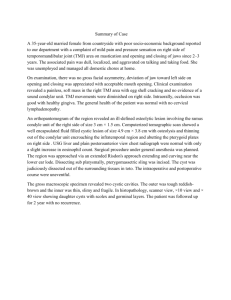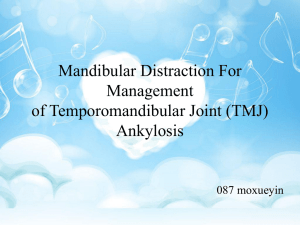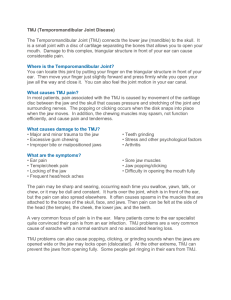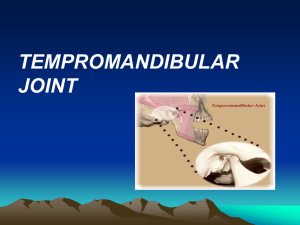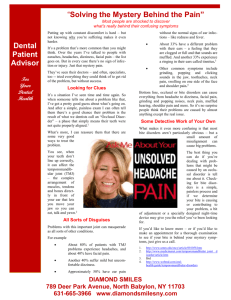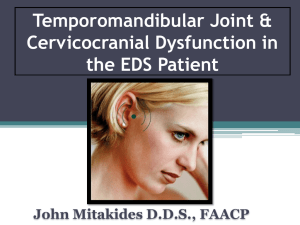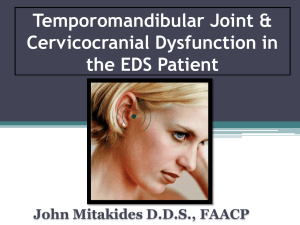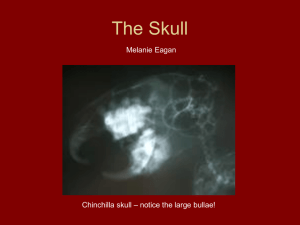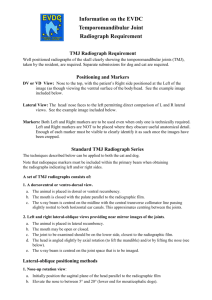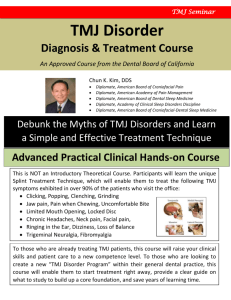TMJ & Muscles of Mastication
advertisement
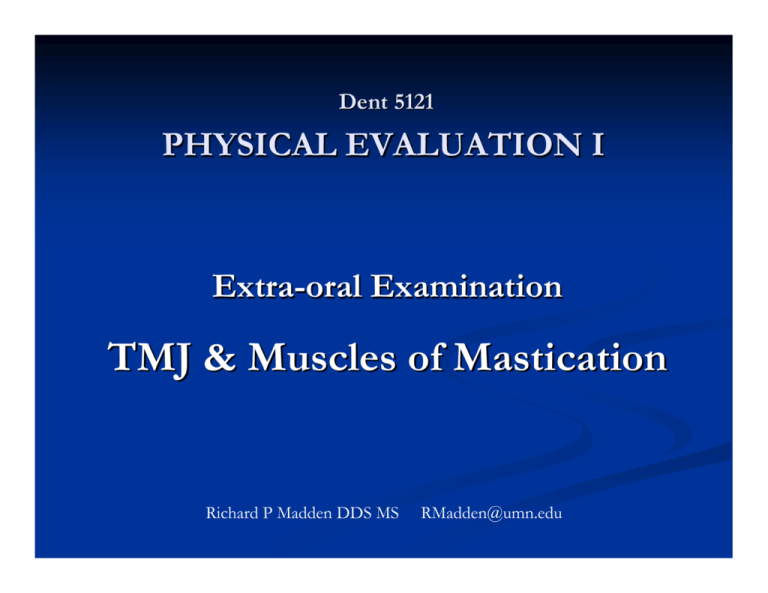
Dent 5121 PHYSICAL EVALUATION I Extra-oral Examination TMJ & Muscles of Mastication Richard P Madden DDS MS RMadden@umn.edu Lecture Objectives After today’s lecture, the student will be able to: Describe the anatomy and function of the temporomandibular joints and muscles of mastication. Describe how to examine the function of the temporomandibular joints and muscles of mastication and how to record the findings in the dental record. Describe some common abnormal findings and disorders associated with the temporomandibular joints and muscles of mastication. Temporomandibular joint Temporomandibular joint Sphenoid Temporal bone Temporomandibular joint www.doctorspiller.com Mandible Muscles of mastication Masseter Temporalis Medial pterygoid Lateral pterygoid http://www.images.md.floyd.lib.umn.edu/users/image_show.asp Muscles of mastication Masseter Temporalis Medial pterygoid Lateral pterygoid Opening, closing, lateral, protrusion, retrusion. Gravity assists with opening The digastric muscle is not considered a muscle of mastication, but is active in opening Temporomandibular Joint Anatomy Temporomandibular joint TMJ capsule Ligaments Holds articualr disc Holds in synovial fluid that lubricates the joint Articular disc Fibrocartilagenous Mostly devoid of blood vessels and nerves Moves with the condyle Temporomandibular Joint Anatomy Temporomandibular joint Compound joint Temporal bone Mandible Articular disc Rotates and translates Rotation: hinge movement Translation: mandible moves forward Ginglyoarthroidal joint Disc Disc 2 Normal TMJ Posterior attachment Articular disc EAM Condyle Articular eminence Lateral pterygoid Normal TMJ - translation Temporomandibular Disorders are functional disturbances of the masticatory system “a collective term used for a number of clinical problems that involve the masticatory muscle, temporomandibular joint (TMJ), and/or EF Wright -Manual of Temporomandibular disorders associated structures.” Muscles of mastication Temporomandibular joints Temporomandibular Disorders Diagnoses involving the muscles of mastication Myalgia Myofascial pain Temporomandibular Disorders Muscles of Mastication Myalgia (muscle pain) Symptoms Pain in localized area of one masticatory muscle (usually masseter or temporalis) Fatigue with chewing Signs Tender muscles upon palpation Sometimes limited active vertical range of mandibular motion Active Range of Motion: How far the patient opens on their own Passive range of Motion: How far you can stretch the vertical opening Temporomandibular Disorders Muscles of Mastication Myofascial pain (muscle and fascia pain) Symptoms Regional pain in area of masseter or temporalis muscles Tinnitus, vertigo, toothache, tension-type headache Fatigue with chewing May have limited mandibular function secondary to pain Signs Multiple tender areas in several masticatory muscles upon palpation Tender areas may refer pain to other locations in face Sometimes limited active vertical range of mandibular motion Temporomandibular Disorders Masticatory Muscle Pain Myofascial pain (muscle and fascia pain) Symptoms (muscle pain) Symptoms Regional pain – many muscles Associated symptoms Tinnitus, headache,etc Fatigue with chewing May have limited mandibular function secondary to pain Signs Myalgia Multiple tender areas Possible referral of pain Possible limited active vertical range of mandibular motion Localized pain – one muscle Fatigue with chewing Signs Tenderness to palpation Possible limited active vertical range of mandibular motion Temporomandibular Disorders Diagnoses involving the temporomandibular joints Disc displacement disorders Inflammatory disorders: Capsulitis/arthritis Subluxation/dislocation Deviation in form Congenital / developmental Ankylosis Fracture Temporomandibular Joint Sounds Temporomandibular Disorders Temporomandibular joints Disc displacement with reduction Symptoms Clicking or popping noise in TMJ May feel “catching” in TMJ Signs Reciprocal click May have deviation in active vertical mandibular range of motion and/or in protrusion No restriction in active vertical mandibular range motion Reciprocal Click: Click is evident both upon opening and closing Anterior Disc Displacement Anterior disc displacement with reduction TMJ sound: Reciprocal click or Reproducible opening click Temporomandibular Disorders Temporomandibular joints Disc displacement without reduction (Closed lock) Symptoms History of clicking or popping noise in TMJ (past, not now) Limited mandibular range of motion Signs No TMJ sounds Restriction in active vertical mandibular range motion and laterotrusion May have deflection in active vertical mandibular range of motion and/or in protrusion Anterior Disc Displacement Anterior disc displacement without reduction TMJ sound: No click Possibly crepitus Temporomandibular Disorders Temporomandibular joints Capsulitis/arthritis Symptoms Pain in TMJ or in front of ear Pain exacerbated by jaw function May have limited mandibular function secondary to pain Signs TMJ tender to palpation TMJ pain worsened upon clenching Limited active mandibular range of motion, laterotrusion, protrusion Temporomandibular Disorders Temporomandibular joints Arthritis of TMJ Symptoms Pain in TMJ or in front of ear Pain exacerbated by jaw function May have limited mandibular function secondary to pain Signs 3 TMJ tender to palpation TMJ pain worsened upon clenching Limited active mandibular range of motion, laterotrusion, protrusion TMJ sound: Fine to coarse crepitus Radiographic / Imaging: Bony changes: Articular, Glenoid fossa Bite changes TMJ Imaging Normal Computed Tomographic (CT) Image of TMJ TMJ Imaging Osteoarthritis / Sclerosis CT Image of TMJ TMJ Imaging Cone Beam CT of TMJ Temporomandibular Disorders Temporomandibular joints Subluxation/dislocation (Open lock) Condylar head moves too far beyond the articular eminence Symptoms Jaw “catches” open when yawning or opening mouth wide (if gets stuck open then dislocation) Pain in TMJ when jaw gets stuck Loud pop when opening wide Signs Excessive active mandibular vertical range of motion Eminence pop Residual tenderness in TMJ upon palpation if recent episode Deviation in Form of TMJ Alteration in surface of: TMJ sound: Articular surface of mandibular condyle Articular surface of articular eminence of temporal bone Superior or inferior surface of articular disc Reproducible opening click Reproducible closing click Reproducible opening and closing click Deviation in form Congenital / developmental Deviation in form of the TMJ Congenital / developmental Alteration in surface of: Glenoid fossa / eminence Articular disc Condylar head TMJ sound: Click, crepitus, pop… Temporomandibular Disorders Ankylosis immobility and consolidation of a joint due to disease, injury, or surgical procedure. (Dorland’s medical dictionary) (bony or fibrous) Fracture a break in continuity of bone (Dorland’s medical dictionary) For the TMJ it would usually be the condylar neck Temporomandibular Disorders Clinical Examination Screening Questions • • • • • • • • Pain in jaw/temples/ears? Fatigue/stiffness in jaw? Difficulty opening? Locking open/closed? TMJ noise? Trauma to jaw/face? Change in occlusion? Oral habits? Screening Examination Range of mandibular motion TMJ Noise Pain Pain to palpation Vertical opening (active) TMJ Masticatory muscles Occlusion Baseline with shimstock (Active vs. Passive opening) Extended Examination Range of mandibular motion Vertical opening Limitation Deviation/deflection Active / passive Limitation Symmetry Limitation Deviation/deflection TMJ Masticatory muscles Occlusion Noise Pain Pain to palpation Protrusion TMJ Lateral movements Baseline with shimstock Cervical muscles Screening Examination Range of mandibular motion Vertical opening TMJ Noise Pain Pain to palpation Limitation Active TMJ Masticatory muscles Occlusion Baseline with shimstock Active Range of Motion Vertical opening Overlap Adjust for overlap of incisors Overjet Active Range of Motion Normal Active ROM: 40-60 mm Males>Females Pattern of Opening Deviation on Opening The opening pathway deviates from a straight opening, but the midline relationship returns to normal at maximum opening. Deviation on Opening What could cause such a deviation? Which TMJ is involved? Deflection on Opening The midline deviates to one side upon opening. The deviation increases with increased opening and does not return to normal midline relationship until closure. Deflection on Opening What could cause such a deviation? Which TMJ is involved? Lateral Range of Motion Midline off +1 mm left Normal Lateral ROM >7 mm, Males>Females Adjusted for deviation in midlines Looking for symmetry in lateral movements Lateral Range of Motion Left lateral movement 9 mm movement to left - 1mm = 8 mm left lateral range of motion Lateral Range of Motion Right lateral movement 7 mm movement to right + 1mm = 8 mm right lateral range of motion Occlusal Contacts Occlusal Contacts Tempormandibular Joint Locate the TMJ by palpating while patient opens and closes mouth Tempormandibular Joint Palpate TMJ for joint noises Tempormandibular Joint Auscultate TMJ noises (not routinely done) Tempormandibular Joint Sounds Palpation of TMJ After mandibular range of motion assessment Locate TMJ Teeth slightly apart Not clenching Not opening and closing Muscles of Mastication Temporalis Muscle Origin: Insertion: Temporal fossa Coronoid process, anterior border of ramus Function: Elevates and retracts mandible, clenches teeth Temporalis Muscle Anterior, Middle and Posterior portions of the temporalis muscle should be palpated Temporalis Muscle To locate the muscle, have the patient clench. Apply about two pounds of pressure. Temporalis Muscle Anterior Middle Posterior Masseter Muscle Origin: Insertion: Superficial portion – anterior 2/3 of lower border of zygomatic arch Deep portion – medial surface of zygomatic arch Lateral surface of ramus, coronoid process, and angle of mandible Function: Elevates mandible, clenches teeth Masseter Muscle Palpate multiple areas of the masseter muscle Masseter Muscle Anterior superior portion Posterior inferior portion Medial and Lateral Pterygoid Muscles Difficult to palpate and questionable reliability. Temporomandibular Disorders are functional disturbances of the masticatory system “a collective term used for a number of clinical problems that involve the masticatory muscle, temporomandibular joint (TMJ), and/or EF Wright -Manual of Temporomandibular disorders associated structures.” Muscles of mastication Temporomandibular joints
